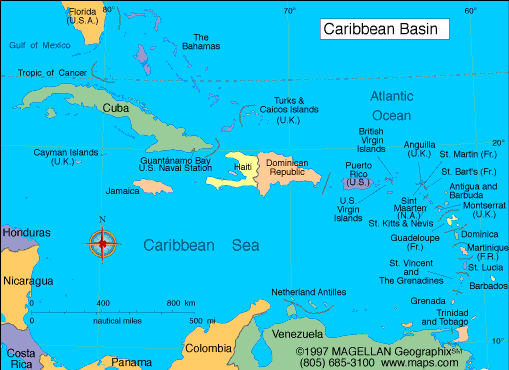
Fairchild Tropical Botanic Garden is a world center for the study and conservation of one of the world's most fascinating biological regions: The Caribbean Islands
Jewels of the Caribbean
by Dr. Javier Francisco-Ortega, Dr. Carl Lewis and Michael Davenport
photos by Eugenio Santiago-Valentin
Winter 2006
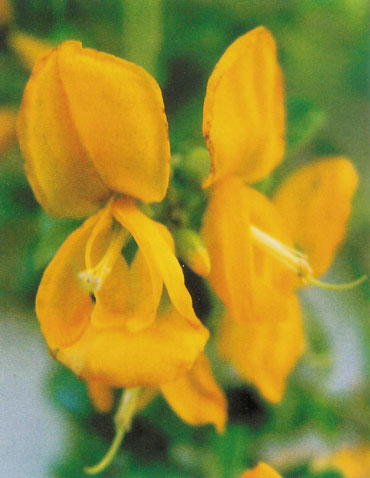
Brya ebenus
These scattered islands are recognized as a biodiversity hotspot — an area of immense biological diversity that is subject to high levels of habitat loss and species extinction. The thousands of 1slands and islets that comprise this hotspot represent a very small fraction of the landmass of our planet, however, they have approximately 7,000 species found only in this region (endemic species). While the Caribbean Island hotspot has no endemic families, it has unusually high levels of endemism at the genus level. Fairchild is one of the few botanic gardens in the world that conducts research on this unique group of plants and displays them as part of its collections. The Jewels of the Caribbean is a unique collection of plantings that demonstrate the diversity of the Caribbean flora in the Lowlands area of the garden. In addition, a number of the region's rarest and most unusual species are found elsewhere in the garden. In its living collection, Fairchild has 17 of the genera endemic to the Caribbean Islands.
Our visitors will find these species to be prime examples of the extraordinary plant diversity of a biodiversity hotspot located very close to Miami. We provide details of each species' location in the garden and a brief account of its distribution, conservation status and ecology. This collection was established with the generous help of our colleagues from various botanical institutions from the Antilles, and we are extremely grateful for their assistance.
1. Auerodendron northropianum
Common names: In Cuba: cocuyo noble, sangre de toro.
Two endemic genera are found within the plant family Rhamnaceae.
Auerodendron has seven species and it is endemic in Cuba, the Bahamas, Puerto Rico and Jamaica.
Auerodendron northropianum is found mostly in coastal forests of Cuba and the Bahamas.
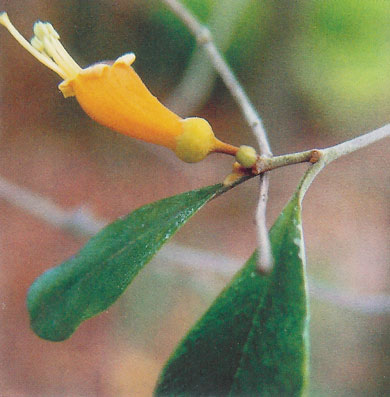
Espadaea amoena
2. Brya ebenus
Common name: In Cuba: espino de sabana, granadillo. In Jamalca: coccus wood; in the West Iindies: ebony.
Genus of the legume plant family (Pabaceae) with five species endemic to Cuba, Hispaniola, Jamaica and Puerto Rico.
The legume plant family has 11 endemic genera.
Brya ebenus is endemic to scrubland, the coastal thorny semi-desert zones of Cuba and Jamaica.
This tree produces a dark colored wood that is highly appreciated in the Antilles, as are the bright yellow flowers.
3. Espadaea amoena
Common names: rascabarriga, arraiján.
This is a true gem at Fairchild.
This genus, together with Coeloneurum, Henoonia and Goetzea (see below) comprised the only plant family endeniic to the Antilles, the Goetzeaceae.
However, recent molecular studies show that this family does not have taxononiic support and currently these four genera are placed with the nightshade plant family (Solanaceae).
Espadaea has one species and it is endeniic to Cuba, where it is relatively common in lowland forests.
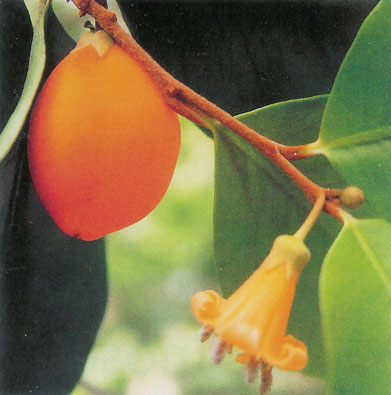
Goetzea elegans
4. Goetzea elegans
Common names: manzanilla, mata buey.
Genus closely related to Espadea (see E. amonea) with two species endemic to Puerto Rico and Hispaniola.
Goetzea elegans is an endangered species from semi-evergreen seasonal forests on limestone from Puerto Rico.
The orange, tubular flowers and bright orange fruits on this small tree make it one of the most handsome gf the genus.
5. Grimmeodendron eglandulosum
Common names: In Cuba: manzanillo, manzanillo de monte, pipiñi; The Bahamas: poison bush.
The poinsettia plant family (Euphorbiaceae) has 11 genera restricted to the Antilles and ranks among the top five families with the highest number of endemic genera: Grimmeodendron has two species and it is restricted in Cuba, the Bahamas, Hispaniola and Jamaica.
G. eglandulosum is a common spec1es from the lowland dry forests of the Bahamas, Cuba and Hispaniola.
Members of the poinsettia plant family are notorious for having toxic and irritang sap, therefore, extreme caution is required to handle this plant.
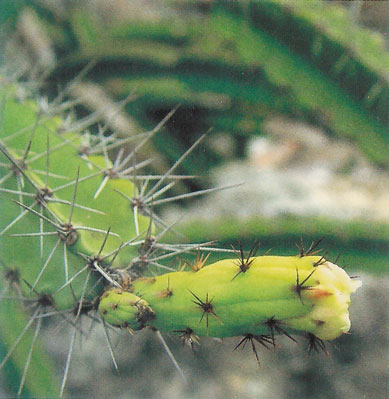
Leptocereus quadricostatus
6. Lasiocroton bahamensis
Common names: In Cuba: cuaba jatía; The Bahamas: wild oat, lightwood bitters.
Lasiocroton is endemic to Cuba, the Bahamas, Jamaica and Hispaniola.
This genus has six species, four of them are found only in Jamaica.
Two of the Jamaican species are extremely rare.
Lasiocroton bahamensis is a common species from lowland and coastal dry forests on limestone of the Bahamas, Cuba and Hispaniola.
Lasiocroton is closely related to another endemic genus, Leucocroton.
The latter has approximately 28 species, and it is one of the most species-rich endemic genera of the Antilles.
7. Leptocereus quadricostatus
Common names: In Puerto Rico: sebucán, pitahaya.
Leptocereus is the only cactus genus endemic to the Antilles.
It has approximately 12 species and is endemic to Cuba, Hispaniola, Puerto Rico, the Virgin Islands and Cayman Islands.
Leptocereus quadricoscatus is an extremely rare species known only from dry forests on limestone in Puerto Rico and the British Virgin Islands.
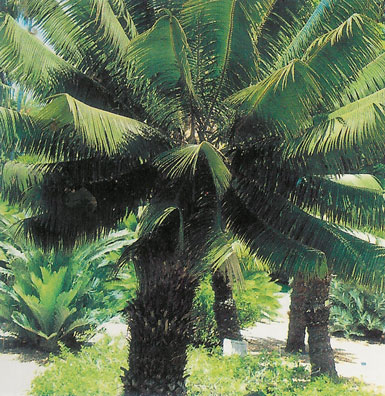
Microcycas calocoma
8. Microcycas calocoma
Common name: palma corcho.
This is the only Gymnosperm genus endemic to the An1illes.
It has only one species restricted to the limestone “mogotes” of Pinar del Rí'o in western Cuba.
The tall cycad is extremely rare, and its habitat was declared a National Monument in Cuba.
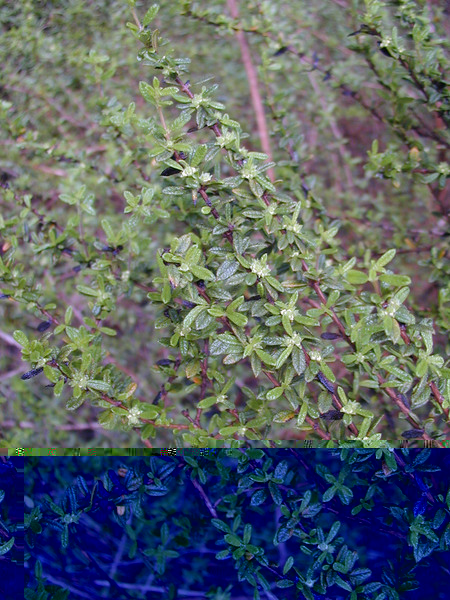
Nashia inaguensis
9. Nashia inaguensis
Common name: In the Bahamas: moujean tea.
The mint plant family (Lamiaceae) has three endemic genera in the Antilles, and we have representatives of these three genera in our living collections.
Nashia has seven species endemic to Cuba, the Bahamas, Hispaniola and Puerto Rico.
Nashia inaguensis is common in lowland dry forests on the island of Great Inagua in the Bahamas archipelago, but rare in Puerto Rico and St. Croix.
The endangered atala butterfly feeds on its tiny flowers.
10. Petitia domingensis
Common names: In the Bahamas: bastard stopper; In the Cayman Islands: fiddlewood; In Cuba: guayo pietro, roble guayo; In the Dominican Republic: capá; In Haiti: calebassier; In Puerto Rico: capá amarillo.
Petitia is another genus of the mint family.
It is endemic to Cuba, the Bahamas, Hispaniola, Puerto Rice, Jamaica and Cayman Islands.
It only has two species.
Petitia domingensis is a common tree from the dry tropical lowland forests of the Bahamas, Cayman Islands, Cuba, Hispaniola, Jamaica and Puerto Rico, and its wood is used to make furruture.
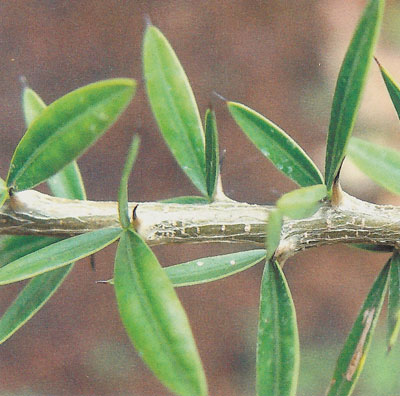
Pictetia sulcata
11. Pictetia sulcata
Common names: In Haiti: bois d'ébène, galle-galle; In the Dominican Republic: cruz del copeyar, palo de tabaco, tabaco, tachuelo, tachuela.
Pictetia is another endemic legume, it has eight species and the genus is restricted to Cuba, Hispaniola and Puerto Rico.
Pictetia sulcata is a common species endemic to Hispaniola and Cuba, where it is found on a diverse array of soils and vegetation types.
Although very spiny, this species has beautiful yellow flowers.
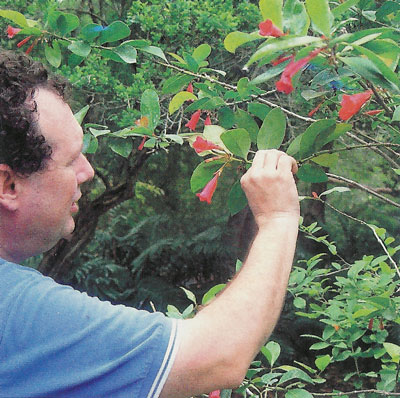
Portlandia coccinea
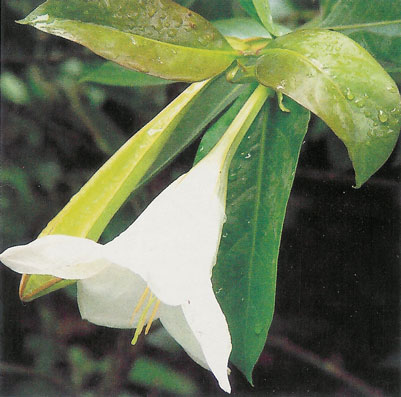
Portlandia grandiflora L.
12. Portlandia coccinea, grandiflora and P. latifolia
Common names: bell flower (P. grandiflora).
The coffee plant family (Rubiaceae) has a high number of endemic genera, 26.
Portlandia is ehdernic to Jamaica, and it has seven speces.
The three species that we have in our collection are locally abundant and occur on limestone montane forests of different parts of the island.
The large flowers of the genus are unusual in this plant family and make it one the Antillean genera with the highest potential for gardening and landscaping.
The white flowers of P. grandiflora are particularly fragrant.
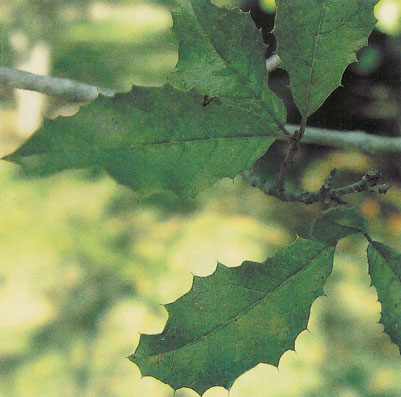
Pseudocarpidium wrightii
13. Pseudocarpidium wrightii
Common names: In Cuba: chicharrón, yanilla blanca, granadillo de costa.
Genus from the mint plant family with eight species endemic to Cuba, the Bahamas and Hispaniola.
Pseudocarpidium wrightii is a shrub found on dry lowland forests of the Bahamas and Cuba.
14. Spirotecoma guantanamensis
The plant family of jacarandas and tabebuias (Bignoniaceae) has two genera endemic to the Antilles. Spirotecoma occurs in Cuba and Hispaniola, the genus has five species. Spirotecoma guantanamensis is endemic to dry lowland forests in eastern Cuba.
15. Stahlia monosperma
Common names: In the Dominican Republic: caobanilla; In Puerto Rico: cóbana, cóbana negra, polisandro.
Genus from the legume plant family with a single species endemic to dry coastal forests from Dominican Republic and Puerto Rico.
Stahlia becomes a medium-sized tree with wood that is used for furniture and fence posts.
Its flowers are yellow, and the fruit is red.
16. Wallenia laurifolia
Common names: In Cuba: camagua; In the Dominican Republic: caimón, caimaní'.
The plant family Myrsinaceae has three genera endemic to the Antilles, two of these genera (Solonia and Vegaea), have one species each.
In contrast, Wallenia has approximately 20 species and is therefore one of the most species-rich endemic genera from the Antilles.
Wallenia is found in the Lesser Antilles, the Bahamas and all the Greater Antilles (except the Cayman Islands).
Wallenia laurifolia is found in dry lowland forests from the Bahamas, Cuba, Hispaniola and Jamaica.
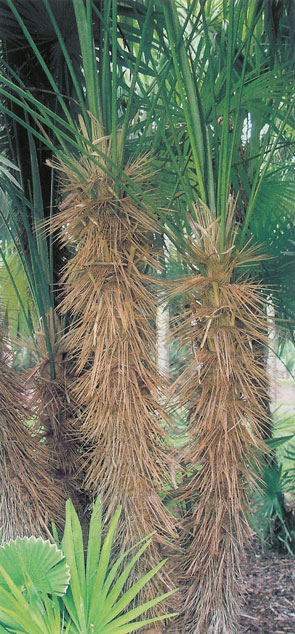
Zombia antillarum
17. Zambia antillarum
Common names: In the Dominican Republic: guanito, guanillo; In Haiti: latanier zombi, latanier pikan, latanier savanne, latanier marron.
This is the only palm genus endemic to the Antillean islands and it has a single species.
The genus is closely related to the Car1bbean Basin gentera Coccothrinax and Thrinax.
Zombia antillarum is restricted to Hispaniola where it grows both in Dominican Republic and Haiti, though not locally abundant.
The name Zombia, its common Haitian name, is a derivation of “zombi” (living dead).
Products of this palm have been used in Haitian culture for hand-crafting, medicinal products and to feed animals.
The palm genera Gastrococos and Calyptronoma were previously considered as endemic to the Antilles,
however recent molecular work conducted by FIU/FTBG graduate student Dr. Julissa Roncal demonstrates that Calyptronoma should be merged with the Central America genus Calyptrogyne.
Studies conducted at Missouri Botanical Garden in close collaboration with Fairchild researchers show that Gastrococos should not be recognized as a distinct genus, but merged with the more widespread genus Acrocomia.
The plants listed in this article represent an important component of the historical and scientific resources of our garden. Several of these species are the subject of major projects of FIU/FTBG graduate sttldents, of horticulturalists working in the Living Collections and Garden Landscapes department and of researchers at our Center for Tropical Plant Conservation. The majority of the ecosystems found in South Florida have close affinities with those found in the Caribbean Island hotspot. We believe that by studying the biology and reasons for the continuous decline of the plants listed in this article, we can learn how to preserve the unique environments of the southern extreme of tne Florida peninsula.
Scientific research and horticulture of Caribbean Island genera in the Garden
Research and conservation of plants restricted to the Caribbean Islands represent an important component of the projects at our Center for Tropical Plant Conservation (CTPC) and Living Collections and Garden Landscape department. These plants are obvious targets for our work since they grow in a biodiversity hotspot located in the backyard of South Florida. Our pioneering research with this endemic genera is helping define the main plant components of the Caribbean Islands. Plant biodiversity in this hotspot is seriously threatened by poverty, overexploitation of natural resources and uncontrolled human development. It is estimated that less than 2% of the natural forest remains in Haiti. ln addition, our scientific understanding of these genera mostly comes from old taxonomic studies conducted in the late 19th and early 20th centuries. At Fairchild, we are developing several programs with these genera and strive to learn their conservation status and to understand their biology using the modern techniques found in our facilities.
All of our research with Antillean plants is conducted in close collaboration and partnership with botanists from the Antilles. The ultitmate goal of our work is to preserve these plants for future generations. Below are some examples of our projects with these plants.
Our Curator of Palms and Cycads, Christie Jones and the head of our joint molecular facilities with FlU, Dr. Javier Francisco-Ortega, are actively working with the critically endangered Microcycas calocoma. Jones has pollinated three cones this year, and we have germinated some seeds from a cone harvested in the spring of 2005. Fairchild is one of the few institutions outside of Cuba that has successfully germinated this species in over 15 years. Dr. Francisco-Ortega uses cutting-edge DNA data to determine the taxonomic relationships between Microcycas and other cycads from the New World.
Our FlU/FTBG graduate student Brett Jestrow is currently doing his Ph.D. project on the taxonomy of Lasiocroton and Leucocroton. His research is being supported by the U.S. Environmental Protection Agency since most of the species of Leucocroton have a restricted distribution on soils with high nickel content. Indeed, these species are remarkable because they can accumulate some of the highest known amounts of nickel in their leaves. These species have an extraordinary potential to recover soils with high levels of heavy metals particular in areas after extensive mining and industrial activities.
The Director of our CTPC, Dr. John Pipoly, is working on the taxonomic classification of the Wallenia species. His work is based on the study of modern methods using anatomical, morphological and molecular methods. The last taxonomic revision of this genus was done in 1904. Since this is one of the most species-rich endemic generas, there is a clear need for an updated classification.
Garden researchers Dt. Carl Lewis and Dr. Scott Zona are currently using DNA and morphological information to understand the taxonomic relarionships of Zombia with Coccothrinax and Thrinax. These three genera account fot most of the species diversity of palms in the hotspot. The last taxonomic review within this group was conducted in the middle of the 20th century and is in urgent need of updating.
As part of our joint research projects with colleagues from the Smithsonian Institution, the United States Department of Agriculture in Miami and Universidad de Puerto Rlco at Río Piedras, we are preparing a checklist of the endemic genera and an assessment of their conservation status. We have found that some of the genera have not been seen since they were discovered more than 80 years ago, and that a great proportion of them have a very restricted distribution in the hotspot.